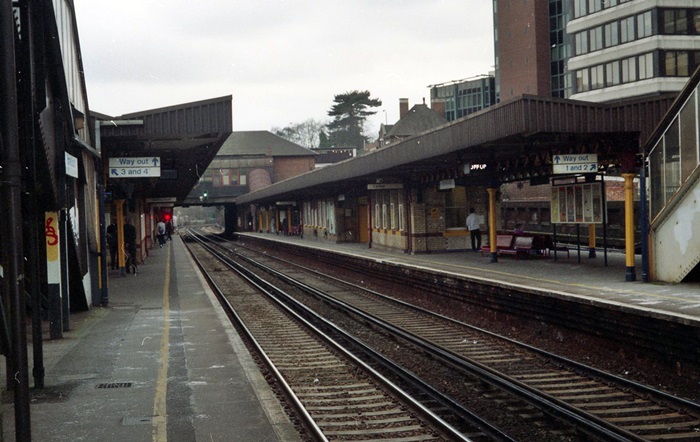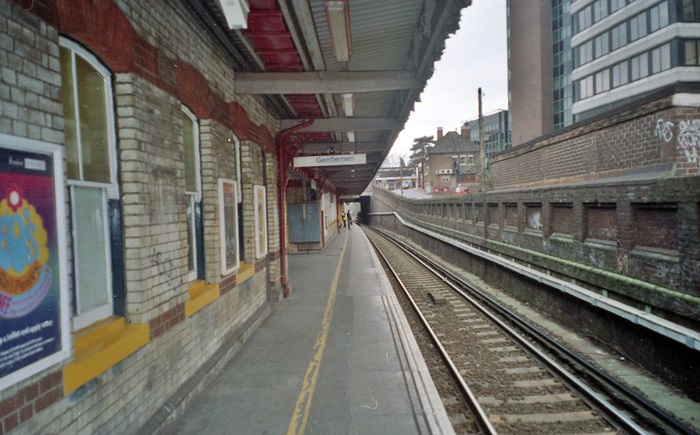

Bromley South
Beyond Bromley existed a 20-mile gap in the railway, up until to Strood. At the
latter, the metals of two companies merged: those of the South Eastern (SER) and
East Kent Railways (EKR). In brief, the SER had reached Strood with their North
Kent Line in 1849 and the company’s decision not to extend this east over the
Medway to Rochester and Chatham, and thence to Faversham, led to the formation
of the independent EKR. The EKR Act came into being on 4th August 1853, which
allowed the company to build a 48˝-mile double-track line between Strood and
Canterbury. At Strood, it was the EKR’s intention to run over the SER’s North
Kent Line, through which it would eventually be able to make a connection with
the WEL&CPR’s network, thus providing access to the proposed West End terminus
of Victoria.
East Kent Railway Openings
- Faversham to Chatham: 25th January 1858
- Chatham to Strood: 29th March 1858
The SER countered the EKR’s proposals, claiming that the North Kent
Line was already at capacity and was unable to accommodate extra trains. A less
than perfect solution saw carriages of EKR trains attached to the rear of SER
services at Strood and conveyed over the North Kent Line to London. This was to be
an interim measure for the EKR, since the company took the decision to pursue an
independent route to the capital, joining up with those fledgling lines in
the Bromley area. The EKR's plan was to link up with the Mid-Kent at St Mary
Cray, through an extension of its own line from Strood (as mentioned in the
earlier
Bromley Record excerpt).
East Kent Railway
- Faversham to Canterbury: 9th July 1860
- Faversham to Whitstable: 1st August 1860
- Strood to St Mary Cray: 3rd December 1860
Victoria Station & Pimlico Railway
-
Battersea to Victoria station: 1st October 1860
Mid-Kent (Bromley to St Mary's Cray)
-
Southborough Road (Bickley) to St Mary Cray: 3rd December 1860
The EKR was known as the ‘’London Chatham & Dover Railway’’ (LC&DR) from 1st
August 1859. On 3rd December of the following year, direct running between
Canterbury and London Victoria, via Chatham and Bromley, was possible. Quick
expansion in the east saw Herne Bay reached on 13th July 1861, Dover on 22nd of
the same month, and Ramsgate on 5th October 1863. By an Act of 7th August 1862,
the LC&DR was authorised to lease the Mid-Kent (Bromley to St Mary Cray),
this coming into effect on 1st September of the following year.
The LC&DR had overcome one rival, the SER, but the company now had the London,
Brighton, and South Coast Railway (LB&SCR), its neighbour at Victoria station,
to contend with. The WEL&CPR, the lines of which the LC&DR used westwards from
Beckenham to reach Victoria, had been purchased by the LB&SCR in 1859.
Naturally, the latter levied toll payments on the LC&DR and gave preference to
its own trains on the line. This saw the building of an avoiding line by the
LC&DR between Beckenham and Battersea, which bypassed the existing WEL&CPR route
to provide a quicker, more direct line to Victoria, ensuring the company was not
at the mercy of the LB&SCR.
LC&DR Openings
-
Stewarts Lane (Battersea) to Herne Hill: 25th August 1862
- Herne Hill to Beckenham: 1st July 1863
During the twenty years following commencement of through running between London
and Canterbury over the LC&DR route, the population of Bromley more than
doubled. This was a prosperous and rapidly expanding borough, which received a
second railway line to the capital in the late 1870s. Promoted as the
‘’Bromley Direct Railway’’, this was a venture backed by the SER and involved
construction of a 1˝-mile-long branch from Grove Park. Opened on 1st January
1878, the branch offered a shorter distance to London (Charing Cross), although
the LC&DR route still had quicker journey times between Victoria and Bromley.
Hereafter, the stations were known as ‘’Bromley LCDR’’ and ‘’Bromley SER’’.
The growth of railway traffic led to the birth of a couple of relief schemes
aimed at taking pressure off the London end of the existing LC&DR main line. The first
received Royal Assent on 12th August 1889 under the name of the ''Shortlands &
Nunhead Railway Company'', today better known as the ‘’Catford Loop’’. This
opened on 1st July 1892; it left the course of the Crystal Palace/Greenwich Park
line at Nunhead and joined the main line at Shortlands. Originally leased by the
LC&DR from the independent concern, it was purchased outright in 1896.
Coinciding with this project was that of quadrupling the main line between
Shortlands and Bickley, a route mileage of 2Ľ. This project began in 1893 and
involved rebuilding of stations at Shortlands, Bromley, and Bickley.
Both Bickley and Bromley received ‘’high-level’’ station buildings
during quadrupling works, as per the rebuilt Chatham, which straddled the tracks
and faced onto a road bridge. These were attractive and pleasing single-storey
structures, which featured crčme brickwork and slated hipped roofs, frescoed
with orange brick lining around curved windows. A pair of island platforms,
about 610-feet-long, were constructed at both sites, those at Bromley extending
east from the station building. At platform level, crčme brick offices and
waiting rooms were constructed, whilst copious protection from the elements was
provided by splendid canopies on each island. These were of a triangular
cross-section, sporting intricate timber valances upon an iron framework, and
chimneystacks from the platform offices protruded through their roofs. The
platforms were linked by an enclosed timber footbridge which backed onto the
rear of the ‘’high-level’’ station building.
27th February 2004

By the time of this view, the footbridge of 1986 was under a thick layer
of grime, the canopies continued to wear dreary corrugated metal valances,
but at least the platform offices looked well-cared for.
© David Glasspool
27th February 2004

Just sailing through: a ''Eurostar'' formation is seen nearing journey's
end as it passes platform 3 in the ''up'' direction, Waterloo-bound.
© David Glasspool
27th February 2004

Spruce crčme brickwork and ornate canopy brackets are evident in this
westward view of platform 4.
© David Glasspool
<< Previous
Next: The History Continues >>
Return to the
Kent Rail Homepage or alternatively, check for
Updates.
Website & Copyright information -
Links -
Contact the Webmaster
All content is
copyright ©
David Glasspool
unless otherwise stated



